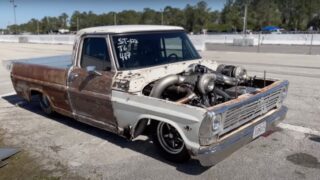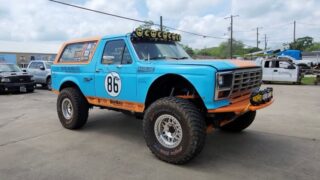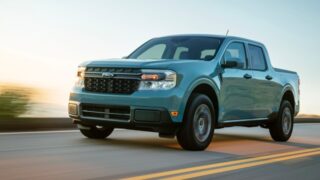1961-1966 Ford F-Series Custom Dash
By John Thomas
Here is a picture of the dash I built for my 1965 Ford. This will work on any
years from 1961 thru 1966.

First I took the dash apart and got out the
plastic piece that will be used (it is neo angle and must be used for the new
one, it’s the one that coutours to your dashboard). I then took a sharp
implement like a dental tool and etched around the bezel that houses the
speedo and the fuel gauge and the water temp. You can leave your speedo in
(no numbers though) and all your other gauges while building the dash. Just
re hook up the Amp gauge and the oil pressure gauge and tape the connections.
Take the plastic piece that you have removed from the truck and with the
sharp implement cut all the way through removing the speedo bezel from the
housing. Then use a small grinder (I used a Makita 4" grinder) and make the
back of the plastic piece flat, remove all the plastic protrusions and get it
ready to attach an aluminum backing. Cut a piece of 1/16" aluminum to fit
the back of the housing and then cut a filler where the speedo bezel used to
be (I used plastic that matched the thickness of the existing plastic). This
is just a filler. Attach the aluminum to the back of the housing to give it
some strength and make sure you bend it to fit the curve so it does not
distort the original shape. This is done so it will screw right back into
with the original 8 screw.
Drill holes through the plastic and the aluminum
and counter sink the flat head screws, on the front side, to hold the
aluminum back piece on. You’ll need to put two screws on top of the lower
bezel since there is no meat left after removing the speedo bezel. Counter
sink those screws and bondo them and when you get ready to paint the part of
the bezel that is visible you won’t see the screws. I bought a piece of ABS
plastic big enough to fit inside the existing housing. It has a texture to
it and a lot of hot rodders use it for their custom dashes. Cut the ABS to
fit, cut and fit till it fits perfect. After that is done use C clamps to
hold the ABS in place and space your gauges the way you want them. I used
VDO gauges, an electrical programmable speedometer that is really nice. I
didn’t use an Amp gauge but used a volt meter instead. Use a 2 1/16" hole
saw for the four gauges (volt, fuel, water tepm and oil pressure). Use the
proper size hole saw for the speedo and the tach (VDO offers a 3 1/8" or 3
3/8" tach and speedo).
I bought a kit from Sacramento Vintage Ford that came
with all the gauges and senders but had to order the tach separate. I
ordered the "Cockpit Royale" which looks really nice. After you have made
the holes for your gauges you use the mounting system for the gauges to hold
the ABS to the housing. This is plenty strong and you don’t see any mounting
screws. I then bought 1/4" idiot lights for a right and left green turn
indicators and red for the amp light, oil pressure light and high beam
indicator. Just use the same wires. Those year Fords had only one green
light for the turn signals but there is already two wires, one for right and
one for left so you just need to pick up a ground and you have a left turn
signal and a right one. Install the senders as per instructions using the
existing wires. Pick up power for the volt meter and all the other gauges
from the existing ignition wires that are behing the dash. Make sure when
you are doing your wiring that you use a 10/32" screw to hold the wires that
went to the amp gauge. This is your charging circuit and must be connected
together.
I then put heat shrink tubing over the connection (the volt gauge
takes the place of the amp gauge but you still have an amp idiot light). I
added another ground to the ground screw that is already behind the dash. I
made up a wire loom on my coffee table so after I had it all done I just
labeled all the wires before I disconnected them from the old gauges and
identified which one was the sender wire and which one was power (color coded
so this was easy). After you finish with all the installation of the gauges,
take it completely apart and sand the plastic down to the grew plastic, using
finer and finer sandpaper. I primed mine and sander it again then I painted
it gloss black. Be careful re-installing the gauges and installing it in
your dashboard so as not to scratch it. If you scratch it, no problem. Just
tape it off and re paint the part that is scratched.
The wiring process is
the most time consuming of all the work. After it’s all wired just install
the housing with your new gauges and that’s it. It does take a bit of
mechanical and electrical skill but the results are worth it. Once you have
taken the dash apart it all become apparent what is happening. The only
original piece that is used is the dash bezel that screws to your dashboard
with 8 screws, you can throw away the black speedo numbers, the clear plastic
and the back metal housing. Everything is mounted to what you just made and
strengthened.




